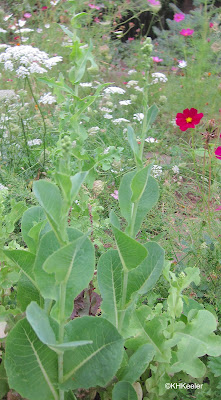Let us talk about lettuce.
 |
| garden lettuce, Lactuca sativa, in a garden |
Lettuce is easily overlooked and yet it is one of the top ten vegetables, traded, grown, or eaten. Americans ate an average of 12.7 pounds of lettuce each in 2021 and 25.8 pounds per person in 2015. It is the world's most important salad crop.
Lettuce is easy to grow and most people liked or at least tolerate it. There are many varieties catering to different tastes.
 |
| lettuce crop |
 |
| head lettuce, growing |
 |
| Lettuce plants in flower (ignore the garden flowers behind the lettuce) |
Lettuce has a long history as a medicinal plant. Ancient Egyptians considered lettuce an aphrodesiac, and dedicated it to their god of fertility, Min. The Greeks likewise considered lettuce to increase fertility, placing it under the Adonis, god of rebirth. Lettuce is sufficiently nutritious that it may enhance sexual energy just by increasing overall health. In addition, ethnobotanists suggested that the milky sap, reminiscent of semen, led to the association with fertility.
From at least the Middle Ages, lettuce has been an herb for treating excess sexual desire. (Is this the opposite of enhancing fertility? Probably.) Dioscorides (64 CE) wrote that "seed of it being dranck, doth help such as dreame continually & doth avert conjunction" (Gunther v. II, 165) which apparently means "helps involuntary ejaculation and discourages coitus" (Storl p. 161). Culpeper's advice, 1600 years later, was "It abates bodily lust, represses venereous dreams, being outwardly applied to the cods (testicles) with a little camphor" (Culpeper p. 213). He probably meant lettuce juice, but applying a lettuce leaf is a soothing image.
The Romans ate lettuce at the end of the meal to induce sleep. It has been recommended for causing sleepiness and countering insomnia for a very long time. The lactucins of lettuce sap have sedative action.
 |
Traditional European medicine, from Dioscorides to modern times, recommended lettuce as an appetite stimulant; that, too, has some chemical basis.
Both European and Ayurduvedic medicine told nursing mothers to eat lots of lettuce to keep their milk flowing. Recent medical studies using concentrated extracts from lettuce, confirm that it is helpful to lactating women.
Lactucin, a sesqueterpine lactone, has analgesic and sedative properties, and some antimalaria effects. It is a major component of lactucarium, the milky fluid in the leaves and stems of garden and other lettuces. Lactucarium was called "lettuce-opium" in the 19th century and used like opium in medicine, attractive because it wasn't addictive. Two 20th century studies found no actual effect of lactucarium so it fell out of favor. More recent studies agree that lactucarium does have sedative and analgesic properties, though there is discussion of whether preparations maintain activity. The quantity of lactucarium in modern commercial lettuce leaves is pretty small since it contributes to the bitterness of lettuce.
 |
Eating lettuce helps keep people hydrated, since the leaves are 95% water. Most lettuce varieties are rich in Vitamins A, C, and K, foliate (a B vitamin) and more. Thus, lettuce is nutrionally valuable which, added to the lactucarium, probably explains much of its medicinal value.
European herbalists such as Macer (1200s) cautioned that eating too much lettuce could make you blind.
The Roman Emperor Augustus (63 BCE-14 CE), seriously ill, ate a lettuce diet when other treatments failed. He recovered. Delighted, the Emperor reportedly erected a monument to lettuce or to the freedman-physician, Antonius Musa, who directed the diet. I find more support for the latter story than the former. (Caesar salad is apparently named after its inventor, the chef Caesar Cardini, and has no relation to Augustus Caesar).
Folklore says: plant lettuce seeds in the name of someone you love. If they grow well, so will the romance between you.
Give those lettuce leaves in your salad more respect!
 |
| lettuce in a salad |
Comments and corrections welcome.
References
AGMRC (Agricultural Marketing Resoure Center). 2021. Letuce. www.agmrc.org link (Accessed 3/25/23).
Caesar Salad. Wikipedia (or any general web search). link (Accessed 3/25/23)
Culpeper, N. 1880. Culpeper's Complete Herbal. Originally 1652. Foulsham Press, London. There are dozens of editions of Culpeper as facsimilies on Open Library, from the last 200 years. Most have a different text from the one I quoted. Here is the link to the edition I have. link I don't know whether the difference is a condensed edition or Victorian prudery.
Cunningham, S. 1985. Cunningham's Encyclopedia of Magical Herbs. Llewellyn Publications. St. Paul, MN.
Dunmire, W. W. 2004. The Gardens of New Spain. University of Texas Press, Austin, TX.
Gunter, R. T. (editor) 1934.The Greek Herbal of Dioscorides. (Englished by John Goodyer A.D. 1605) Oxford University Press. Oxford.
Kim, H. D., K-B. Hong, D. O. Noh, and H. J. Suh. 2017. Sleep-inducing effect of lettuce (Lactuca sativa) varieties on pentobarbital-induced sleep. Food Sci Biotechnol. 2017; 26(3): 807–814. link (Accessed 3/24/23)
Look and Learn. Archive Picture History. 1966. A Diet of Lettuce Saved the Roman Emperor Augustus. www.lookandlearn.com link (Accessed 3/25/23).
Millspaugh, C. F. 1974. American Medicinal Plants. Originally 1892. Dover Publications, New York.
O'Hanlon, D.P. (translator) 1981. Macer's 'Virtue of Herbs'. (Originally 1200) Hemkunt Press. Delhi, India.
Riley, G. 2007. The Oxford Companion to Italian Food. Oxford University Press, Oxford.
Ryder, E. J. and T. W. Whitaker. 1995. Lettuce Lactuca sativa (Compositae). pp. 53-56. Evolution of Crop Plants. 2nd ed. Smartt and Simmonds. Longman Scientific and Technical. London.
Stearn, W. T. 1997. Stearn's Dictionary of Plant Names for Gardeners. Cassell Publications, LTD. London.
Storl, W. D. 2016. A Curious History of Vegetables. North Atlantic Books, Berkeley, CA.
Topos Text. Antonius Musa https.topostext.com link (Quotes from Roman sources mentioning Musa and Caesar Augustus, but not lettuce.) (Accessed 3/25/23).
Yakoot, M. S. Helmy, and K.Fawal. 2011, Pilot study of the efficacy and safety of lettuce seed oil in patients with sleep disorders. Int. J. Gen. Med. 2011; 4: 451–456. link (Accessed 3/24/23)
No comments:
Post a Comment